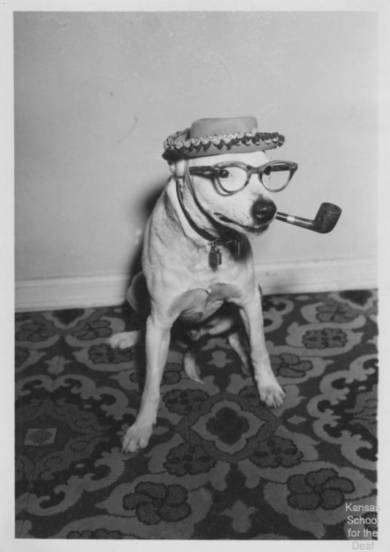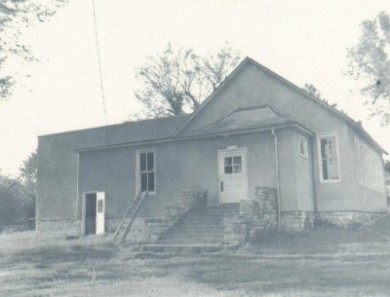
Shawnee Methodist Mission (Photo courtesy of the Johnson County Museum Collection on JoCoHistory)
The Shawnee Methodist Mission was originally located around present day Turner, Wyandotte County, but in 1839, it relocated to Johnson County at 3403 W 53rd St, in Fairway. At one time, there were 13 small buildings and 3 large buildings, but the 3 larger buildings, East, West, and North, are all that remain on the campus today. Twenty-three different Indian nations were represented including the Shawnee from Ohio. Because of the Indian Removal Act of 1830, a treaty was signed giving the Ohio Shawnee lands in Kansas. The Shawnee Methodist Mission was a manual training school, where they learned basic academics, manual arts, and agriculture until 1862.
The First Territorial Capital of Kansas was in Pawnee, part of present day Fort Riley, but those in the legislature wanted to move closer to Missouri, so for 23 days in 1855, the mission served as the second capital of the Kansas Territory. After 1862, the location included “a boarding house, a brothel, a frequent gathering spot for rowdies and ruffians passing through the open spaces and as a speakeasy”.(1) During the Civil War it served as barracks for the Union troops. There was very little upkeep after the closing of the school. However, in 1927 the state acquired the property. Work to restore the property commenced and the North building was completed in 1942.

Women at the Shawnee Indian Mission (Photo courtesy of the Johnson County Museum Collection on JoCoHistory)

Shawnee Indian Methodist mission under reconstruction (Photo courtesy of the Johnson County Museum collection on JoCoHistory)
The North building was used as a dormitory and school for girls. They learned spinning, weaving and other domestic arts. Some of the Shawnee embraced the Methodist religion and approved their children’s attendance. Some of the children were happy to go to a mission school because they were fed better than when they lived at home. However, they also were given new names, new clothes, and their hair was cut on admittance to the school.

Shawnee Indian Methodist mission (Photo courtesy of the Johnson County Museum collection on JoCoHistory)
One little Shawnee girl, Emily, whose parents were Reverend Lewis McNiff, a white man, and Math-Ah-Pease, attended the school. Emily’s mother Math-Ah-Pease married again to a man by the name of James Blue Jacket, hence Emily Bluejacket. Records show she was at the mission in 1844 as Emily Bluejacket but they also differ on her age. According to the 1857 Kansas State Census an Emily Bluejacket was at the mission was 18.
The 1854 Treaty with The Shawnee stated that each single Shawnee person was entitled to 200 acres. Emily Bluejacket was entitled to 200 acres and part of her land was where Grinders in Lenexa is today, SE 1/4 of section 4, township 013S, range 024E. We find that Emily married Charles Barth in 1859 who took off to seek his fortune during the gold rush in California, never to return. She then married Joseph Nipp in 1866 and had 2 boys, and eventually moved to Oklahoma. The land changed hands several times, including the owner Icy Snow Beard in the 1930s, until it was purchased by Endicott Properties and a restaurant, Stonewall Inn opened as a restaurant with a pub-like atmosphere. This restaurant closed down in 2002 but Grinders Stonewall owned by Jeff Rumaner, opened in 2014 after 8 months of renovations.

Stonewall Inn (Photo courtesy of the Johnson County Museum collection on JoCoHistory)
-Terri Bostic, Johnson County Library
(1)Thomas Johnson’s Story and the History of Fairway, Kansas, by Joe H. Vaughan, pg 14
https://www.kshs.org/kansapedia/shawnee-indian-mission/11913
Editor’s Note: There will be more JoCoHistory blogs in the future detailing a fuller history of the Mission, and the Johnson County Museum will host a travelling exhibit about Native American boarding schools in 2023.























